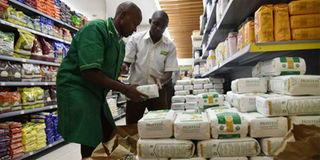Fix the ‘unga’ puzzle once and for all

Workers arrange maize flour at a supermarket. FILE PHOTO | NMG
What you need to know:
- Then, farmers had to sell their maize at a throwaway price of Sh800 per 90kg bag to brokers.
- Every two kilogrammes of maize leaves the farm at about Sh56, based on NCPB’s highest buying price.
The cyclical and fluctuating prices of unga (maize flour) in the country have always pointed to a serious problem in the maize value chain.
The past one month has seen maize flour prices rise from an average Sh112 per two-kilogramme packet to the current Sh136 across the country.
This comes as a surprise to many people, considering that the country was experiencing a “glut” only last season.
Then, farmers had to sell their maize at a throwaway price of Sh800 per 90kg bag to brokers. The National Cereals and Produce Board (NCPB) bought the commodity at Sh2,300, which was raised to Sh2,500 by President Uhuru Kenyatta in January this year.
HIGH PRICES
Whereas consumers are having to pay substantially high prices to access the commodity, its primary producers have nothing to show for it.
Every two kilogrammes of maize leaves the farm at about Sh56, based on NCPB’s highest buying price. The hundreds of thousands of bags that were sold at Sh800 would translate to Sh18 per two kilogrammes of maize flour.
So, what happens in between? At local mills, the cost of milling two kilogrammes of maize is about Sh10; it costs only Sh10 extra to make it finer.
What is packed and retailed in shops is grade one flour milled by big millers enjoying economies of scale, which, ideally, should translate to even lower costs.
I am not convinced that the cost of transporting the maize to millers and distributing the processed product to retail shops can account for the difference.
Millers have many ways of accessing maize — including through the government-funded NCPB stores across the country, direct purchases from farmers, from other dealers as well as imports with the help of government.
FAVOURABLE PRICES
Recently, they got a shot in the arm when the President appealed to his counterpart in Tanzania to help them to access the grain in that country at more favourable prices.
But why do we import?
To understand this conundrum, we first need to analyse the production numbers. In 2018, Kenya produced 46 million bags of maize — the highest amount ever — despite the threats of Fall Armyworms that had invaded the country. The Ministry of Agriculture estimates the current maize consumption at around 55 million bags per year. This leaves a deficit of about 10 million bags of maize meaning we would only need to import 18 per cent of the total maize consumed.
This deficit cannot be used as an excuse to hike the maize prices.
We have enough storage facilities owing to the NCPB-declared capacity of 1.8 tonnes — which translates to about 20 million 90kg bags. Despite being shared among the different cereals produced in the country, it is, nonetheless, sufficient capacity, given that the agency is also allowed to outsource facilities from private entities.
STABILITY
What the country needs to focus on, therefore, is the strengthening of NCPB’s role in ensuring price stability and better access to grains countrywide.
Further, the strategic grain reserves should solely exist to safeguard the needs of the over 15 million Kenyans who cannot meet their minimum dietary requirements.
We cannot continue to have the misplaced idea by NCPB of selling grains to animal feed manufacturers when some of our compatriots have none to eat.
At the same time, the government needs to rethink its policy of subsidising maize for millers.
By so doing, it creates two opposing systems when it comes to maize trade and regulation. It makes absolutely no sense for the government to pay billions of shillings to millers in form of subsidies if, in return, they cannot regulate the price of unga in the well-organised and united milling industry.
And there is a need to reassess our form of agriculture — the gains and pains of the industrial model of farming that the country has heavily promoted and invested in for the past two decades. To ensure access to affordable food for all Kenyans, we need to have a sober national discourse around whether the fertiliser subsidies work or if farmers are given enough incentives to grow maize.
We should also evaluate whether large-scale monocropping and heavy mechanised forms of farming are compatible with our context or if the price mechanics are right.
These measures will put the country in good stead to fulfilling the human right to food as enshrined in the Constitution in Article 43 1(c), which, unfortunately, the government seems to be in contravention of.
Mr Atamba is a Route to Food Initiative ambassador. [email protected]





